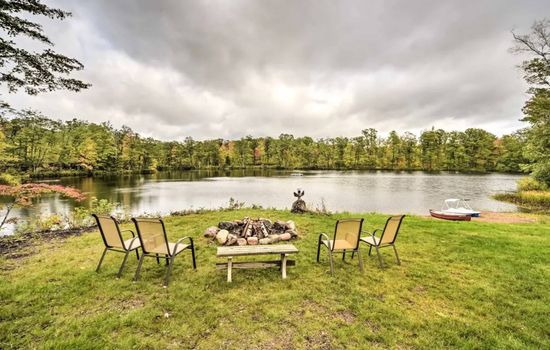The Visitor Center at St. Croix State Park in Minnesota offers information on park activities, maps, and exhibits about local wildlife. It is open from 9 AM to 4 PM daily, with extended hours during the summer months.
Entrance fees are typically around $7 per vehicle. Parking is available, but fees may vary based on the season.
From Minneapolis, take Interstate 35E North, merging onto Highway 8 East. Continue for approximately 50 miles, then follow signs to your destination, where nature’s tranquility awaits amidst lush landscapes and serene waters.
Accessibility & permits
Emergency
- Cell service availability:Full
Information not accurate?
Help us improve by making a suggestion.
St. Croix State Park, Minnesota’s largest state park, invites visitors to experience its breathtaking natural beauty and diverse landscapes. Spanning over 34,000 acres, this expansive park offers a unique blend of lush forests, rolling hills, and meandering rivers, perfect for those seeking both adventure and tranquility. The St. Croix River, a designated National Scenic Riverway, provides opportunities for kayaking, canoeing, and fishing, making it a haven for water enthusiasts.
Hiking enthusiasts will find solace on the park’s extensive trail system, which caters to all skill levels. The trails wind through vibrant woodlands and offer stunning views of the rugged terrain. Wildlife abounds here; keep an eye out for deer, foxes, and a variety of bird species that call this park home. Each season brings its own charm, from vibrant fall colors to serene winter landscapes ideal for cross-country skiing.
St. Croix State Park is more than just a destination; it’s an escape into nature’s embrace, perfect for families, couples, and solo travelers alike. Whether you seek adventure or simply wish to unwind in a picturesque setting, this park delivers an unforgettable experience.
Top 3 Facts about St Croix State Park
During the fall migration, rare sightings of the endangered Kirtland’s warbler occur, as these birds travel thousands of miles from their breeding grounds in Michigan to wintering sites in the Bahamas, showcasing the remarkable journey of this species, which relies on specific habitat conditions for survival.
In this park, unique microclimates create diverse ecosystems, leading to phenomena like sudden temperature drops and unexpected snowfall, while extreme temperature variations can occur within just a few miles, showcasing the region’s complex weather patterns and their impact on local flora and fauna.
This expansive area boasts the longest hiking trail in Minnesota, the Willard Munger State Trail, while its bizarrely named routes like “The Bump” challenge adventurers, and unusual rules prohibit the use of motorized vehicles on certain trails, ensuring a serene experience for all outdoor enthusiasts.
Family programs
- Junior Ranger
- Ranger-led Tours
- Self-guided Tours
- Workshops & Hands-on Activities
- Living History & Cultural Demos
- Scavenger Hunts
- Night Sky & Astronomy
- Family Camping & Overnight
- Volunteer & Stewardship
- Youth Conservation
- Scouting Partnerships
- Virtual Junior Activities
- Arts & Crafts
- Water-based Adventures
Travel Tips
Plan Ahead
When planning your visit, consider the season and weather conditions, as they can greatly affect your experience. Pack essential gear, including sturdy hiking shoes and weather-appropriate clothing, and make reservations for campsites well in advance, especially during peak seasons. Research trails and activities ahead of time to ensure you make the most of your adventure in this stunning natural landscape.
Pack Appropriately
When preparing for your adventure in Minnesota’s stunning natural landscapes, consider packing a lightweight, waterproof dry bag for your essentials. The area’s diverse terrain includes rivers and wetlands, making it easy for unexpected weather or splashes to dampen your gear. This simple addition ensures your belongings stay dry, allowing you to fully immerse yourself in the beauty of the outdoors.
Respect Wildlife
When exploring this natural haven, prioritize wildlife respect by maintaining a safe distance from animals and refraining from feeding them. Observe their behaviors quietly to enhance your experience and contribute to their natural habits. Carry binoculars for a closer look without intruding, and remember to stay on marked trails to protect both the ecosystem and its inhabitants.
Stay Informed
Before heading out, stay informed by checking the weather, temperatures, and any fire bans or notices. Know the emergency contact information and tell someone your destination and expected return time to ensure your safety during your visit.
Seasons
In spring, the park’s 127 miles of trails beckon hikers to explore blooming wildflowers and lush forests, while the St. Croix and Kettle Rivers offer serene canoeing and fishing opportunities.
Summer’s warm embrace invites visitors to explore 127 miles of hiking trails, paddle the serene St. Croix and Kettle Rivers, and unwind at the picturesque Lake Clayton beach.
In fall, the park’s vibrant foliage and tranquil river vistas offer an idyllic retreat, with September through November providing crisp air and brilliant colors for hiking, canoeing, and camping.
Embrace the winter season with exhilarating cross-country skiing, snowshoeing, and snowmobiling adventures, as well as serene candlelight hikes, all set against the park’s picturesque snowy landscapes.
Information not accurate?
Help us improve by making a suggestion.
Where to stay
Frequently Asked Questions
Ready to dive into what St Croix State Park has to offer? Let’s tackle some of the burning questions you might have as you plan your visit!
-
St. Croix State Park offers a variety of camping options, including drive-in campsites, walk-in sites, and group camping areas. The park features over 100 campsites equipped with picnic tables and fire rings, with some sites offering electrical hookups. Additionally, there are rustic cabins available for rent, providing a more comfortable camping experience. For those looking for a unique experience, there are also canoe-in sites accessible via the St. Croix River.
-
To rent a canoe or kayak at St. Croix State Park, visitors can head to the park’s visitor center where rentals are available during the summer months. The park also partners with local outfitters who may offer additional rental options. It’s advisable to check availability in advance, especially during peak season, and to inquire about rental rates and any necessary permits.
-
Wildlife enthusiasts can expect to see a diverse range of animals in St. Croix State Park, including deer, foxes, and a variety of bird species such as bald eagles and herons. The park’s varied habitats, including forests, wetlands, and rivers, provide excellent opportunities for wildlife observation. Keep an eye out for beavers and otters near the water, as well as numerous amphibians and reptiles throughout the park.
-
Yes, St. Croix State Park features several hiking trails suitable for beginners. The trails are well-marked and vary in length and difficulty, making them perfect for families and novice hikers. The 6-mile St. Croix Trail offers a scenic walk along the river, while shorter loops provide easier options for those just starting out.
-
The campgrounds at St. Croix State Park offer several amenities to enhance your camping experience. Facilities include restrooms, drinking water, and picnic areas. Some campgrounds have shower facilities, and there are designated fire pits for cooking and warmth. Additionally, the park provides access to hiking trails, fishing spots, and canoeing opportunities, making it a well-rounded destination for outdoor enthusiasts.


